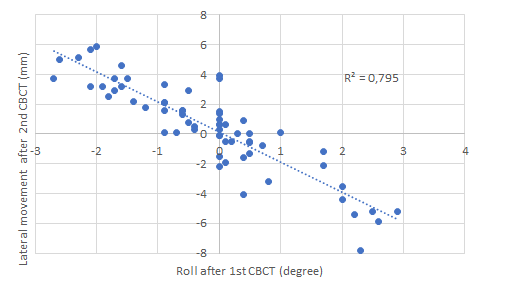Additional position corrections after CBCT imaging on a 6 DoF couch for SBRT lung patients
PO-1875
Abstract
Additional position corrections after CBCT imaging on a 6 DoF couch for SBRT lung patients
Authors: Tiina Seppälä1, Assi Valve2, Anu Anttonen2
1Comprehensive Cancer Center (CCC), University of Helsinki and Helsinki University Hospital, Radiotherapy, Helsinki, Finland; 2Comprehensive Cancer Center (CCC), University of Helsinki and Helsinki University , Radiotherapy, Helsinki, Finland
Show Affiliations
Hide Affiliations
Purpose or Objective
The purpose of this study was to evaluate the impact of the rotational movements to the patient treatment position after CBCT-based IGRT of the SBRT lung patients.
Material and Methods
The retrospective study consists of twelve lung patients, ten of them had surface-based positioning and follow-up during the treatment. The final positioning of the patient’s treatment site was based on pre-treatment 3D CBCT images with six degrees of freedom (6 DoF) Perfect Pitch couch system (Varian, Palo Alto, USA). The second CBCT scan was taken between the treatment fields.
Eleven patients had one PTV and one patient three PTVs in lung, eight PTVs located in left lung and six PTVs in right lung. Sixty-four fractions (1-8 fractions/patient) were evaluated.
The quality assurance of the 6 DoF couch with 80 kg weight on the table-top was done with CBCT images and the Quasar Penta-Guide cubic phantom with wedge under the phantom to estimate the rotational accuracy of the treatment couch.
Results
Based on the 1st CBCT images, the treatment couch movements were on average (±1SD) vertically 3.6 ± 8.7 mm, longitudinally 3.7 ± 3.8 mm and laterally 3.2 ± 3.7 mm and the rotations in the direction of pitch 0.7±0.8°, roll 0.8±0.9° and couch rotation 0.9±1.0°. The movements based on the 2nd CBCT images were on average (±1SD) vertically 1.4 ± 1.5 mm, longitudinally 1.2 ± 1.6 mm and laterally 1.8 ± 1.9 mm.
After the roll rotation (rotation about the longitudinal axis) of the couch, additional lateral movement of the patient was required. The couch roll rotations of 1° and 2° caused lateral displacements of 2 mm and 4 mm for the patient (Fig. 1). The linear correlation squared R2 was 0.795 (Fig. 1). Smaller correlation squared R2 was observed after pitch rotation (rotation about the vertical axis) and was 0.419.
Fig.1 The correlation of the roll rotation after 1st CBCT couch movement and the 2nd CBCT lateral movement.
The accuracy of the 6 DoF treatment couch rotations (roll and pitch) were within 0.2°.
Conclusion
Special care must be taken if correcting over 1 degree roll or pitch rotations of the treatment couch in the SBRT lung radiotherapy, because there seems to be patient related compensatory movement that requires extra correction if the roll correction is >1 degree. After a roll or a pitch more than 1 degree, a new CBCT image must be taken to confirm the patient’s treatment position.
References
Caillet V, Booth JT, Keall P 2017, IGRT and motion management during lung SBRT delivery, Phys Med 44:113-122.
Schmitt D, Blanck O, Gauer et al. 2020, Technological quality requirements for stereotactic radiotherapy : Expert review group consensus from the DGMP Working Group for Physics and Technology in Stereotactic Radiotherapy, Strahlenther Onkol.196(5):421-443.